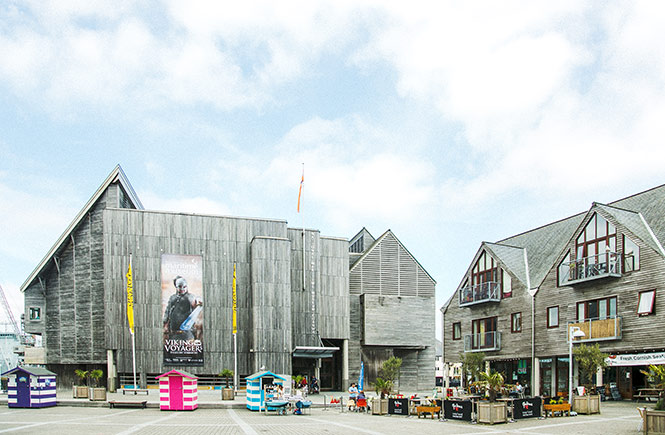
The sea has always provided food, livelihoods and an essential trade link to the outside world for the people of Cornwall. Not surprisingly, boats and seafaring form a huge part of its cultural heritage. Together with Carrick Roads, its main port of Falmouth is the third deepest natural harbour in the world, the town’s fortunes owing much to its maritime past, present and future. The starting point for numerous expeditions, naval conquests and yacht races for hundreds of years, Falmouth is also home to the multi-award winning National Maritime Museum Cornwall.
Situated on Discovery Quay, the museum holds the National Small Boat Collection as well as its own collection of Cornish and other small boats. Its mission is to promote an understanding of boats and their place in people’s lives, and of the maritime heritage of Cornwall. Exploring Cornwall’s fishing, trading, boatbuilding, wrecks and emigration history, you’ll be amazed at how innovative and courageous Cornish seafarers were, the Falmouth Packet story, those plucky mail ships servicing the Empire, warranting a mini exhibition of its own.
But you don’t have to be a sailor to appreciate the wealth of ‘boaty’ artefacts and information on display. Equally fascinating for landlubbers of all ages, it’s the stories of the people who sailed and adventured in these boats that make this museum really come alive, and those of intrepid seafarers today – still battling the elements, beating the odds, respecting the mighty ocean, and sailing on the high seas.
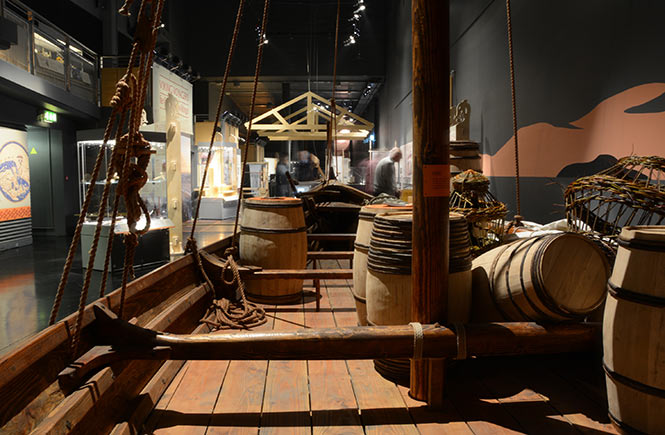
With fifteen galleries over five floors, housing a varied mix of permanent and temporary exhibitions, and lots of hands-on activities, there’s plenty to see and do. The hard part is deciding where to begin. We headed to the top, right to the top of the 100ft Look-out Tower, where we caught the tail-end of a talk given by one of the friendly volunteers. The views over Falmouth harbour are stunning, and help put where you are into context. From vast cruise ships, to gunmetal grey naval vessels, to pleasure boats of all shapes and sizes, moored up as far as the eye can see, it’s worth the stair climb for this panorama alone.
From here we went down, right down to the Tidal Zones, where enormous 22ft windows give you a glimpse into the harbour’s natural underwater environment. It’s like looking at a giant aquarium full of shrimp, barnacles, fish (seals if you’re lucky) or going scuba diving without the hassle of tanks and all the kit. Cormorants occasionally do dive-bys as well. No mermaids when we were there though.
The main attraction on the ground floor, Viking Voyagers, invites you on an epic journey to discover the truth behind the popular myth of these bloodthirsty raiders. On until January 2nd 2017, this world-class exhibition offers a rare opportunity to see antiquities on loan from the British Museum, National Museum of Ireland, National Museum of Denmark and Manx National Heritage.
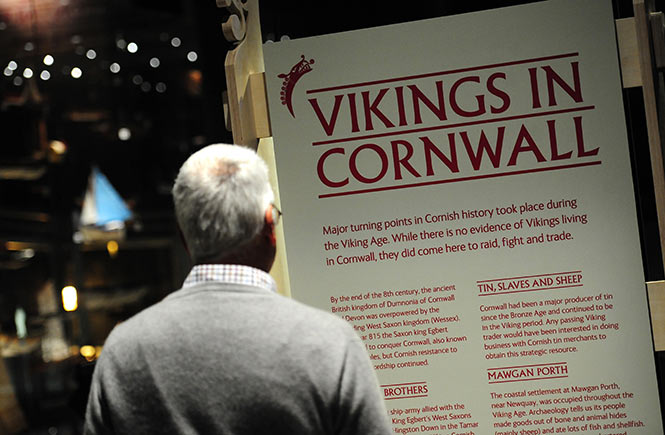
Expert seamen and navigators, their name for the sea was ‘whale road’, and for 300 years (700 –1050) Vikings looted, traded and settled on four continents as far as Canada and Iraq. They also made landfall in Cornwall, with Viking coins and pins having been found in Hayle and Phillack, and a bronze stirrup in Sennen.
Largely known for their warring tendencies, turns out Vikings were early recyclers too, actively re-using materials and repairing their vessels, with any that were too far gone being burnt, and the nails retrieved from the ashes. An average sized boat required: 90 trees, 480kg iron (8000 nails) 200kg wool, 2200m cordage, and 50,000 man hours to build – commonly clinker construction, the same as Cornish gigs! Women were tasked with spinning and weaving to make the material for the sails, as well as for clothing, blankets, bags and tents.
A full scale 14m climb aboard replica cargo ship provides a real flavour of what it might have been like to go ‘Viking’. Built by the Falmouth museum team, broad and very shallow, it would’ve been crewed by 5-8 men, trading staples of oats and butter, exotic spices, beads and even slaves. Waxed leather hoods and ethically sourced sheepskins you can dress up in, plus sniff and smell barrels of ale and salted fish, those little extras that make visiting this exhibition a far cry from just Googling it.
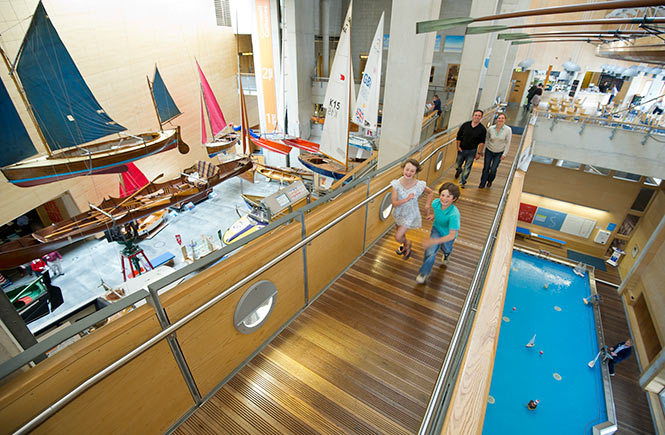
Also on the ground floor is the Survival Zone, detailing stories of unbelievable human endurance and hope, from Tony Bullimore who was plucked from icy seas five days after his boat capsized, to Sir Ernest Shackleton and crew’s incredible 800 mile journey in a lifeboat, after their ship had been crushed in pack ice in the Weddell Sea. And the Robertson family of four and a friend, who survived for 38 days in the Pacific in a tiny dinghy, mainly due to Lyn Robertson’s skills as a nurse.
And if you’ve ever wondered what it was like to be a lighthouse keeper, there’s a lovely exhibition about Godrevy Lighthouse too. Considered sacrilege to take the kettle off the boil, tea was their lifeblood. Keepers were generally good bakers and cooks, experts at cards and board games, cross-stitch and embroidery, read an awful lot of books, and polished with Brasso daily. You can also try your hand at semaphore, signalling messages with flags. Pick your letters right and it’s possible to do a passable impression of Night Fever disco dancing.
On until February 21st, Mermaids at Sea, highlights the hidden histories of women who have embraced the challenges of the open seas, making their mark in a male dominated world. From Mary Lang, who crewed on the last Windjammer to sail from South Australia to Cornwall in the 1930s, to Dame Ellen MacArthur, the fastest woman ever to circumnavigate the globe solo, their stories are brought to life using film, photography and fascinating objects.
Kids are well catered for, particularly during holiday periods, thanks to an exciting workshop programme featuring storytelling, craft activities, theatre shows and themed events to coincide with guest exhibitions. Fully accessible too, wheelchair users rate the museum as being brilliant. Guide dogs and hearing dogs are welcome, while many of the interactive exhibits and objects on display, and oral history and music audio, are ideal for people with sensory impairment.
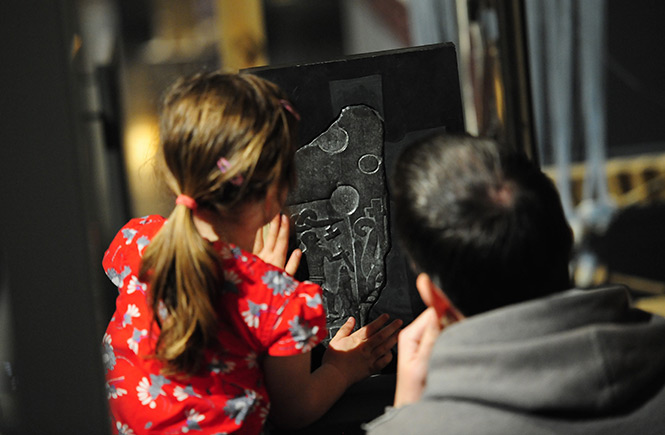
Grab a cuppa or some lunch at the Waterside Café, have a go at sailing a mini radio-controlled yacht, learn all about weather systems, why boats float and more. Fun and educational, you don’t need to wait for a rainy day to enjoy visiting one of Cornwall’s premiere attractions. Exceptional value for money, if you’re planning a return visit to Cornwall, tickets are valid for multiple entry for a full 12 months from the date of purchase. For opening times and further information, visit: www.nmmc.co.uk
Stay in Falmouth >
Find out more about days out in South Cornwall >
Tags: Falmouth | South Cornwall |